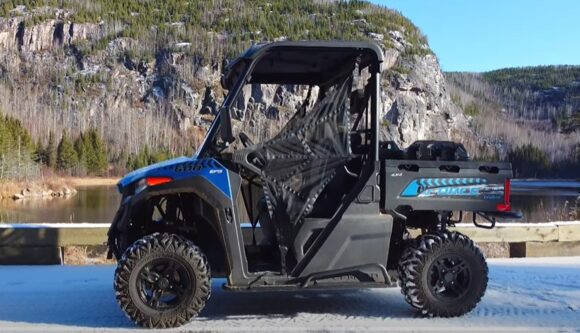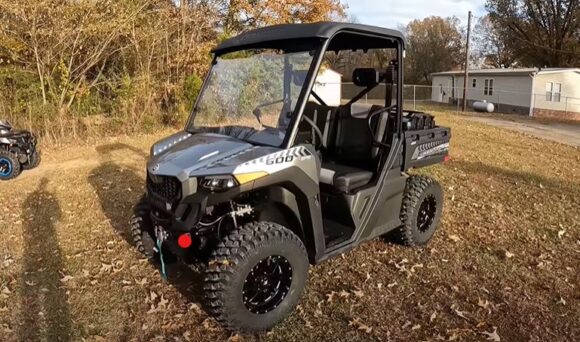The Linhai Big Horn 28 has been on the market for some time and is a well-liked utility vehicle. Although it lacks the consumer recognition of better-known brands, this UTV stands out from the crowd thanks to its many unique characteristics.
However, this simple yet extremely competent UTV has various shortcomings and issues that you should be aware of.
The Linhai Bighorn 28 UTV has sometimes trouble starting and no spark, electrical difficulties such as a low battery, engine stalling when accelerated, idling issues, and clutch slipping issues.
Keep reading to learn more about the Linhai Bighorn 28 problems and solutions associated with this UTV.
Linhai Bighorn 28 Problems
The Linhai UTV’s clutch assembly, factory battery, and starter system are some of the common problems.
The following are a few more difficulties that are typical with these UTVs.

1. No spark, no Crank and Won’t Start
A common issue with Bighorn 28 UTVs is that they crank but fail to start. Sometimes it starts up and runs well for a while, but eventually dies and won’t start again.
When it won’t start, there is no spark at the plug wire’s end.
This issue plagued mostly the 400cc engine. Starting problems could be caused by clogged jets in carburetor, faulty or tainted fuel in the gas tank, or a stuck starter clutch.
The Fix:
The best method for validating a CDI is to use another CDI. Most China CDIs are inexpensive, abundant, and prone to failure.
2. Idle Issue
This UTV has some problems with idling. It fires up without a hitch, but it won’t keep idling once it’s warmed up.
It won’t go anywhere below about 2500 RPM, and you’ll need to keep the choke on.
Its high rate of idling makes it impossible to shift gears without damaging them. The vehicle has a rough idle and is difficult to start.
There must be something seriously wrong with the gas in the UTV, or the jets in the carburetor are blocked.
The Fix:
You can try adjusting the carburetor. This might occur if the air-fuel mix screw is adjusted to a too-lean setting.
Assuming there are no other issues, lowering the machine’s idle speed can be accomplished by adjusting the idling speed screw once the proper mixture has been achieved.
If that doesn’t work, you might have to take the carburetor apart to clean or inspect it.
3. Malfunctioning Clutch
The clutches on these UTVs don’t work properly. The vehicle’s clutch has a tendency to slip, and this condition is known as a slipping clutch, which is a situation in which a vehicle’s clutch is not fully engaged.
A faulty clutch cable can also cause the clutch to slip, making it difficult to shift gears smoothly.
If the clutch’s weight spring and clutch shoes are worn, broken, or loose, the clutch won’t engage. It’s possible for the clutch to slip if the primary sliding sheave is seized.
An incorrectly placed primary clutch is another possible source of clutch problems.
The Fix:
All broken or worn clutch parts must be replaced. Ensure sure the weight spring of the clutch is tight. The main sliding sheave needs to be inspected.
Replace a damaged clutch cable or have it fixed.
If the clutch problem cannot be fixed, you may need to replace the entire clutch assembly.
4. Battery Runs Very Low
The battery is extremely low in Bighorn 28. If you jump-start the vehicle and let it idle to recharge the battery, the higher amperage would fry the components.
These Chinese ATVs/UTVs have faulty electrical components. Crimp connections and wire gauges are deficient.
Due to weak batteries, these inexpensive Chinese quads don’t survive more than two 30-second starts.
However, the starters require a higher current than what the power cords can provide.
The Fix:
Replace the faulty battery. Replace the wires connecting the battery to the solenoid and the solenoid to the starter with a larger wire.
Make sure your UTV battery is properly charging.
5. Stalls When Accelerated
After accelerating for a few seconds, the Linhai Bighorn 28 will suddenly stop moving, acting as though it has run out of fuel.
While accelerating and driving, you can keep the engine running by releasing the choke and adjusting the accelerator pedal.
When you let off the gas, it will keep idling without stalling indefinitely.
The Fix:
This could be the result of a clogged fuel filter, a faulty pump, or dirt or water in the carburetor.
First, make sure the carburetor is receiving a sufficient fuel supply. If not, you may need to clear out the fuel filter. Take the carburetor’s fuel hose off and see if the fuel is flowing freely.
Finally, clean the carburetor.
Which Year Linhai Bighorn 28 Has the Most Problems?
There is limited information regarding the Linhai Bighorn 28 UTV. This UTV is an entry-level mid-size four-wheeler manufactured by the Jiangsu Linhai Group and was launched in 2011.
It is straightforward and powerful, with a 28-horsepower engine.
The model years 2012 and 2013 are the ones that have the majority of problems.
2012 model year is plagued with problems like difficulty shifting, engine-related issues, starting problems, faulty fuel delivery system, clutch problems etc.
The 2013 year on the other hand has electrical issues, starting difficulties with whining noises are reported.
Conclusion
The Bighorn 28 is a robust UTV that can handle off-roading and other outdoor adventures easily. This UTV is sturdy despite its basic construction.
However, this Chinese-made UTV is not free from problems. Users have reported various issues related to this UTV.
Now take a glance at common Linhai Bighorn 28 problems here below –
- Problems getting the Linhai Bighorn 28 to start, often accompanied by whining sounds, are not uncommon.
- It would fire up but won’t keep idling.
- Some units come stock with LA batteries that are reportedly poor in performance.
- There were many clutch issues with previous Linhai models.
- When accelerated the UTV starts bogging down.
Even with these problems, the Bighorn was able to change many off-roaders’ minds about Chinese-made vehicles. The brand is also gaining popularity among budget-conscious buyers who want a reliable UTV.
Arctic Cat Prowler 1000 Problems
Arctic Cat Prowler 650 Problems


